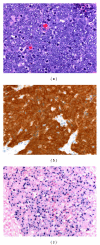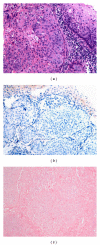Ancillary studies in determining human papillomavirus status of squamous cell carcinoma of the oropharynx: a review
- PMID: 21772959
- PMCID: PMC3137958
- DOI: 10.4061/2011/138469
Ancillary studies in determining human papillomavirus status of squamous cell carcinoma of the oropharynx: a review
Abstract
Squamous cell carcinoma (SCC) of the oral cavity and pharynx represents the sixth most common form of malignancy worldwide. A significant proportion of these cases are related to human papillomavirus (HPV) infection. In general, HPV-associated SCC is more commonly nonkeratinizing and poorly differentiated, whereas non-HPV-associated SCC is typically keratinizing and moderately differentiated. Nevertheless, significant overlap in morphology is seen between these two forms of SCC. The purpose of this paper is to highlight the utility of ancillary studies in the establishment of HPV status of oropharyngeal SCC, including p16 immunohistochemistry, high-risk HPV in situ hybridization, polymerase chain reaction, and newer HPV detection modalities.
Figures


References
-
- American Cancer Society Facts and Figures. http://www.cancer.org/acs/groups/content/@epidemiologysurveilance/docume....
-
- Adelstein DJ, Rodriguez CP. Human papillomavirus: changing paradigms in oropharyngeal cancer. Current Oncology Reports. 2010;12(2):115–120. - PubMed
-
- Allen CT, Lewis JS, Jr., El-Mofty SK, Haughey BH, Nussenbaum B. Human papillomavirus and oropharynx cancer: biology, detection and clinical implications. Laryngoscope. 2010;120(9):1756–1772. - PubMed
-
- Feller L, Wood NH, Khammissa RA, Lemmer J. Human papillomavirus-mediated carcinogenesis and HPV-associated oral and oropharyngeal squamous cell carcinoma. Part 2: human papillomavirus associated oral and oropharyngeal squamous cell carcinoma. Head and Face Medicine. 2010;6, article 15(1) - PMC - PubMed
LinkOut - more resources
Full Text Sources
Research Materials
